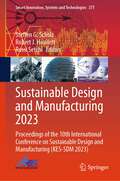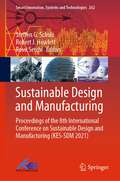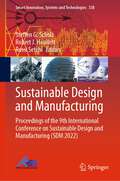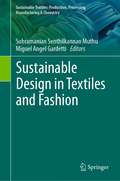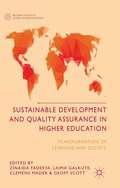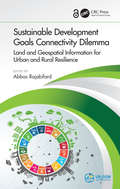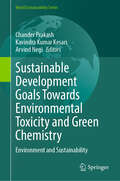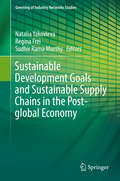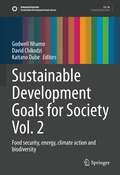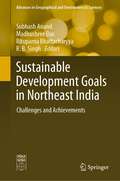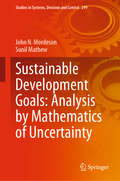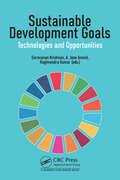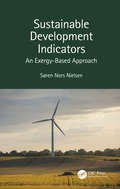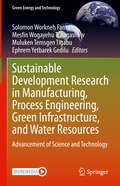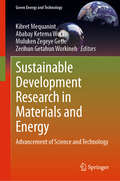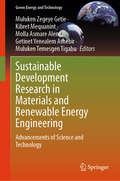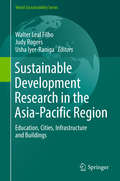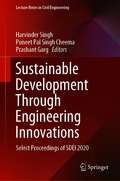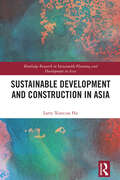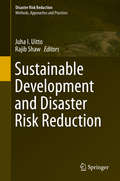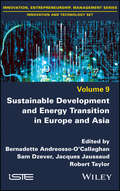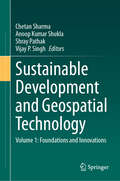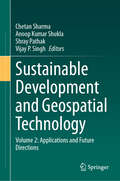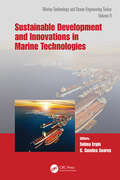- Table View
- List View
Sustainable Design and Manufacturing 2023: Proceedings of the 10th International Conference on Sustainable Design and Manufacturing (KES-SDM 2023) (Smart Innovation, Systems and Technologies #377)
by Robert J. Howlett Rossi Setchi Steffen G. ScholzThe book consists of peer-reviewed papers presented at the International Conference on Sustainable Design and Manufacturing (SDM 2023). Leading-edge research into sustainable design and manufacturing aims to enable the manufacturing industry to grow by adopting more advanced technologies and at the same time improve its sustainability by reducing its environmental impact. Relevant themes and topics include sustainable design, innovation and services; sustainable manufacturing processes and technology; sustainable manufacturing systems and enterprises; decision support for sustainability; and Industry 4.0 and Intelligent Manufacturing. Application areas are wide and varied. The book provides an excellent overview of the latest developments in the sustainable design and manufacturing area.
Sustainable Design and Manufacturing: Proceedings of the 8th International Conference on Sustainable Design and Manufacturing (KES-SDM 2021) (Smart Innovation, Systems and Technologies #262)
by Robert J. Howlett Rossi Setchi Steffen G. ScholzThis book consists of peer-reviewed papers, presented at the International Conference on Sustainable Design and Manufacturing (SDM 2021). Leading-edge research into sustainable design and manufacturing aims to enable the manufacturing industry to grow by adopting more advanced technologies and at the same time improve its sustainability by reducing its environmental impact. Relevant themes and topics include sustainable design, innovation and services; sustainable manufacturing processes and technology; sustainable manufacturing systems and enterprises; and decision support for sustainability. Application areas are wide and varied. The book will provide an excellent overview of the latest developments in the sustainable design and manufacturing area.
Sustainable Design and Manufacturing: Proceedings of the 9th International Conference on Sustainable Design and Manufacturing (SDM 2022) (Smart Innovation, Systems and Technologies #338)
by Robert J. Howlett Rossi Setchi Steffen G. ScholzThe book consists of peer-reviewed papers presented at the International Conference on Sustainable Design and Manufacturing (SDM 2022). Leading-edge research into sustainable design and manufacturing aims to enable the manufacturing industry to grow by adopting more advanced technologies and at the same time improve its sustainability by reducing its environmental impact. Relevant themes and topics include sustainable design, innovation and services; sustainable manufacturing processes and technology; sustainable manufacturing systems and enterprises; and decision support for sustainability. Application areas are wide and varied. The book provides an excellent overview of the latest developments in the sustainable design and manufacturing area.
Sustainable Design for Global Equilibrium
by Md. Faruque HossainThis book focuses on holistic approaches of applying sustainable practices in all sectors of building, infrastructure, and energy to achieve a best-balanced global energy, building, infrastructure, transportation, and water technology (EBITW) regime. It presents a series of solutions based on innovative research and applications for building a sustainable Earth for future generations. The goal of this book is to define the context of instigation for thinking through the scientific theories and practical applications of sustainability mechanisms to confirm a global equilibrium by the implementation of the following main practices: Sustainable Energy, Sustainable Architectural and Engineering Design Technology, Sustainable Environment and Society, and Sustainable Earth.
Sustainable Design in Textiles and Fashion (Sustainable Textiles: Production, Processing, Manufacturing & Chemistry)
by Subramanian Senthilkannan Muthu Miguel Angel GardettiThis book highlights the Eco-design or Sustainable design in textiles and fashion, aimed at reducing their environmental impact throughout their life cycle. Sustainable design is one of the core elements practiced in various industrial sectors. The textiles and fashion sector, is also creating a huge environmental brunt in terms of various fibres, processes, consumption of various resources including dyes, chemicals and auxiliaries, etc,. Thus, sustainable design is the key to reduce the environmental impacts made out of textiles and fashion products. This book includes seven informative chapters to decipher the concept and applications of sustainable design in textiles and fashion.
Sustainable Development And Quality Assurance In Higher Education
by Zinaida Fadeeva Laima Galkute Clemens Mader Geoff ScottTo help address the challenges of sustainable development, higher education institutions must transform themselves, bringing together best practice in quality management for tertiary education with best practice in education for sustainable development. This book provides tested strategies and pathways for undertaking this successfully.
Sustainable Development Goals Connectivity Dilemma: Land and Geospatial Information for Urban and Rural Resilience
by Abbas RajabifardThe Open Access version of this book, available at https://doi.org/10.4324/9780429290626, has been made available under a Creative Commons Attribution-Non Commercial-No Derivatives 4.0 license. Large-scale migration from rural to urban areas, and between countries, affects sustainable development at local, national, and regional levels. To strengthen urban and rural resilience to global challenges, Sustainable Development Goals Connectivity Dilemma: Land and Geospatial Information for Urban and Rural Resilience, brings together leading international geospatial experts to analyze the role of land and geospatial data infrastructures and services for achieving the United Nations' Sustainable Development Goals (SDGs). While the goals outlined in the 2030 Agenda have been longstanding aspirations worldwide, the complexity and connectivity between social, economic, environmental, and governance challenges are changing with large-scale urbanization and population growth. Structured in 5 parts, the themes and objectives of the book are in line with the critical challenges, gaps, and opportunities raised at all UN-GGIM events and UN-GGIM Academic Network forums. Through the different perspectives of scholars, industry actors, and policy-makers, this book provides interdisciplinary analysis and multisectoral expertise on the interconnection between the SDGs, geospatial information, and urban and rural resilience. Sustainable Development Goals Connectivity Dilemma: Land and Geospatial Information for Urban and Rural Resilience is an essential reference for researchers, industry professionals, and postgraduate students in fields such as geomatics, land administration, urban planning, GIS, and sustainable development. It will also prove a vital resource for environmental protection specialists, government practitioners, UN-GGIM delegates, and geospatial and land administration agencies. Features: Introduces a holistic and new approach to sustainable development Brings together social, economic, and environmental dimensions of sustainability Highlights the significance and the role of geospatial information in sustainable development Examines urban and rural interdependencies in the context of strengthening resilience Written by experts with diverse academic and professional backgrounds who examine connectivity and develop strategic pathways
Sustainable Development Goals Towards Environmental Toxicity and Green Chemistry: Environment and Sustainability (World Sustainability Series)
by Kavindra Kumar Kesari Chander Prakash Arvind NegiThis book thoroughly explores strategies and greener methods, chemical and biological treatments, sustainable chemistry, and technological advancements aimed at mitigating the harmful effects of chemicals on the environment. Modern societies are often exposed to various types of chemicals, originating from natural or man-made sources. These chemicals can cause environmental damage, and their long-term exposure has been found to contribute to deteriorating public health. The increasing global human population has led to higher demand for everyday materials, resulting in unprecedented industrial production levels. This growth also jeopardizes the value-added supply chains of essential chemical industries such as pharmaceuticals, fertilizers, biologics, biotech. Consequently, there is a greater need for the use of sustainable and environmentally friendly methods. For example, in recent years, strategies have been developed to efficiently handle agricultural waste to produce materials, fuel, fine chemicals, and energy.
Sustainable Development Goals and Sustainable Supply Chains in the Post-global Economy (Greening of Industry Networks Studies #7)
by Natalia Yakovleva Regina Frei Sudhir Rama MurthyThis book presents a collection of studies on current best practices for delivering sustainable development policies within supply chains. It critiques the limitations of existing business theory and practice on sustainable supply chain management, and discusses opportunities for new conceptual models for businesses to engage with Sustainable Development Goals (SDGs). It examines how businesses can work towards implementing Sustainable Development Goals in the contexts of entrepreneurial initiative, industry collaboration and regional development. SDGs renew the sustainable development agenda for global communities and ask businesses and organisations to reset their sustainable development policies. A strategy to embed sustainable development principles into business operations along the supply chain operations, which has been a conceptual and, in many instances, practitioner, business and industry achievement of the past decades, is not enough to shift the economic and social conditions of poor populations around the world. How would the global supply chains of the future look like? What social relations does it envisage? How will businesses and organisations engage with societies, environments and complex institutional contexts in emerging markets and developing countries, which are faced with issues of population growth, needed leaps in infrastructure provision, educational and health improvements, cultural and institutional shifts? The books challenges current approaches to sustainable supply chain practices guided by discussion on SDGs. It reviews implementation issues of existing sustainable development approaches, assesses the advancement of sustainable development strategies and examines the opportunities for global value chains to increase their positive social and environmental inputs in regions, communities and organisations. The book collects both conceptual and empirical studies set in a variety of business and organisational contexts, such as manufacturing, retail, procurement, cities and industrial parks. It contests the accepted axioms of sustainable practices in the global supply chains and proposes new models for organisations and production networks to engage with societies and address market and production effects on communities and institutions.
Sustainable Development Goals for Society Vol. 2: Food security, energy, climate action and biodiversity (Sustainable Development Goals Series)
by Godwell Nhamo Kaitano Dube David ChikodziThis book profiles various cases that are emerging in addressing global challenges in the context of SDGs for society in the era of climate change and covers case studies of projects being undertaken to tackle biodiversity, food security, climate change, energy and water security. The book is written by 37 authors, and will appeal to various stakeholders including academics working within the identified thematic areas, policy planners, development agencies, governments and United Nations agencies. The adoption of the Sustainable Development Goals (SDGs) in 2015 ushered a new era in the global development agenda as the world transitioned from the Millennium Development Goals (MDGs). The new era of SDGs that are all-inclusive, unlike the MDGs with the focus now being on ensuring human success that is predicated on environmental protection. The year 2020 marked five years post the adoption of the SDGs with increased calls for stock-taking of progress made amid strong calls for a decade of action to accelerate the delivery of the SDGs by 2030. These calls have been louder now given the impact of the COVID-19 pandemic, which reset the global economy and increased intensity of extreme weather events across the world. Since climate change has emerged as one of the biggest threats to the achievement of the SDGs, there has been growing concerns on its impact on biodiversity loss and the extinction of some species. There are also concerns regarding increased food insecurity at the household level in some parts of the world, particularly in Asia and Africa. With the demand for climate change action on the increase, there have also been growing calls for the big carbon emitters to drastically cut their emissions and invest in clean energy to save the planet by following development pathways making emissions stay under the 1.5°C increase in temperature.
Sustainable Development Goals in Northeast India: Challenges and Achievements (Advances in Geographical and Environmental Sciences)
by R. B. Singh Subhash Anand Rituparna Bhattacharyya Madhushree DasThis book covers themes related to the geosphere, biosphere, sociosphere and ecosphere dealing with changing geographical, environmental and socio-economic realities to plan a sustainable future for the northeast region (NER) of India. The NER consists of eight states—Assam, Arunachal Pradesh, Tripura, Nagaland, Manipur, Mizoram, Meghalaya and Sikkim—and they carry political, economic and social importance. The book integrates the past, present and future of geospheric attributes incorporating progress towards the Sustainable Development Goals (SDGs) to meet the demands for improving human wellbeing under diverse and challenging socio-economic, political and environmental conditions. The key SDGs, as in food and agriculture, health, education, water, energy and other overarching goals of the region, have yet to incorporate providing sustainable jobs and promoting equality and inclusive development, although there have been a few studies in that regard.The challenges to achieve SDGs in the NER are formidable compared to the rest of India. The NER has put a great deal of effort into achieving the SDGs, mainly in poverty (SDG-1), good health (SDG-3), education (SDG-4), gender (SDG-5), decent work (SDG-8) and reduced inequalities (SDG-10), similar to the rest of the country. However, the standard development indicators such as road length, access to health care, power consumption and other measures are far below the national average. A multi-pronged strategy has played a pivotal role in the region, but development strategy to attain the SDGs 2030 must be more inclusive in empowering people with maximising self-governance, considering the resources, needs and aspirations of the people.This book evaluates the performance of the SDGs and fills in the gaps. It includes case studies focusing on different SDGs using advanced cartographic, statistical and GIS techniques and methods. It also provides unique findings that serve as valuable resources for planners and policy-makers so that a sustainable future in Northeast India can be achieved.
Sustainable Development Goals: Analysis by Mathematics of Uncertainty (Studies in Systems, Decision and Control #299)
by John N. Mordeson Sunil MathewThis book uses mathematics of uncertainty to examine how well countries are achieving the 17 Sustainable Development Goals (SDGs) set by the members of the United Nations, with a focus on climate change, human trafficking and modern slavery. Although this approach has never been used before, mathematics of uncertainty is well suited to exploring these topics due to the lack of accurate data available. The authors place several scientific studies in a mathematical setting to pave the way for future research on issues of sustainability, climate change, human trafficking and modern slavery to using a wide range of mathematical techniques. Moreover, the book ranks countries in terms of their achievement of not only the SDGs, but in particular those SDGs pertinent to climate change, human trafficking, and modern slavery, and highlights the deficiencies in the foster care system that lead to human trafficking. As such it is an excellent reference resource for advanced undergraduate and graduate students in mathematics and the social sciences, as well as for researchers and teachers.
Sustainable Development Goals: Technologies and Opportunities
by Raghvendra Kumar Saravanan Krishnan A. Jose AnandSustainable Development Goals (SDGs) are goals set by the United Nations to address the global challenges and foster sustainable development and harmony. To effectively achieve these goals, leveraging advanced technologies and engineering techniques is paramount. This edited volume explores the pivotal role of technology and engineering in advancing the SDGs across various sectors such as green energy, water management, healthcare, agriculture, and smart manufacturing. From innovative solutions in clean energy production to precision agriculture and smart cities, technological advancements offer scalable and efficient approaches to tackle complex sustainability issues.
Sustainable Development Indicators: An Exergy-Based Approach (Applied Ecology and Environmental Management)
by Søren Nors NielsenAnalyzing the self-sufficient Danish island of Samsø, this book explains sustainability through a bio-geophysical understanding of how to best use society’s limited resources to achieve true sustainability. The method used derives from the thermodynamic function of exergy. By analyzing exergy flows and establishing a system for evaluating the energy and the materials used in a society, the author creates a platform for monitoring certain indicators of sustainability. These indicators inform readers about the actions that must be taken and the time frames for achieving sustainability goals. The exergy-based approach is an important tool for carrying out such an analysis because it Focuses on several key thermodynamic concepts and the usefulness of exergy analysis for evaluating sustainability Explains sustainability by implementing thermodynamic laws to societal consumption and the use of resources Discusses new methods that integrate energy and material fluxes and evaluates them against each other Provides direct indicators for finding the largest problems/obstacles and deciding where measures should be taken Includes instructions on how to establish an accounting system for evaluating the energy and the materials used in a society This book is aimed for professionals, researchers, and students working on nature conservation and environmental management projects related to sustainability.
Sustainable Development Research in Manufacturing, Process Engineering, Green Infrastructure, and Water Resources: Advancement of Science and Technology (Green Energy and Technology)
by Solomon Workneh Fanta Ephrem Yetbarek Gedilu Mesfin Wogayehu Tenagashaw Muluken Temsgen TigabuThis book presents current research, recent advances, and emerging technologies on sustainable development issues in manufacturing, industrial processing, green infrastructure, and water resource engineering. Topics covered include sustainable energy, biomass, waste disposal, food processing and preservation, engineering properties, biopesticides, and surface water quality assessment. The book provides researchers, engineers, industry professionals, graduate students, and practitioners with state-of-the-art research on sustainability in developing countries.
Sustainable Development Research in Materials and Energy: Advancement of Science and Technology (Green Energy and Technology)
by Kibret Mequanint Muluken Zegeye Getie Ababay Ketema Worku Zerihun Getahun WorkinehThis book presents current research, recent advances, and emerging technologies on sustainable development issues in materials and energy. It covers various methods, including numerical and experiment analysis. The coverage of materials includes: Advanced manufacturing and materials processing; Biodegradable and bio-inspired materials; Functional materials and their behavior; Investigation on synthetic versus natural fiber; Thermal and strength analysis of bamboo; Materials for energy storage, conversion, and transmission and structural materials; Soft materials, composites, and fibers. Studies on renewable and green energy systems and sources include: Research on wind, solar, and biomass energy conversion systems; Renewable resources potential assessment, energy storage; Energy-saving and efficient technologies; Stirling heat pumps; Human energy acquisition; CO2 capture storage and utilization; Energy conversion systems; Energy policies and economics; State-of-the-art renewable energy conversion systems. The book provides researchers, engineers, industry professionals, graduate students, and practitioners with state-of-the-art research on engineering materials, material science, sustainable energy engineering, and energy technology in developing countries.
Sustainable Development Research in Materials and Renewable Energy Engineering: Advancements of Science and Technology (Green Energy and Technology)
by Kibret Mequanint Muluken Zegeye Getie Molla Asmare Alemu Getinet Yenealem Ashebir Muluken Temesgen TigabuThis book presents current research, recent advances, and emerging technologies on sustainable development issues, engineering materials, and energy technology advancements, particularly in developing countries. It covers various methods, including numerical and experiment analysis. The coverage of materials includes advancements in construction materials and materials processing; biodegradable and bio-inspired materials; functional materials and their behavior; thermal and strength analysis of different materials, materials for energy storage, conversion, and transmission; composites and fibers. Studies on renewable and green energy systems and sources include energy storage; energy-saving technology; energy-efficient technologies; green energy systems; waste heat recovery; energy conversion systems; energy policies economics, and emerging technologies related to energy transformation. The state-of-the-art solar application areas covered include solar thermal systems, solar PV investigations, and solar applications for drying, cooling, and solar collectors. The book provides researchers, engineers, industry professionals, graduate students, and practitioners with state-of-the-art research on engineering materials, material science, sustainable energy engineering, and energy technology in developing economies.
Sustainable Development Research in the Asia-Pacific Region (World Sustainability Series)
by Walter Leal Filho Judy Rogers Usha Iyer-RanigaThis multidisciplinary book focuses on best practices in sustainability research in the Asia-Pacific Region. Drawing links between research, practice, education for sustainability and the needs of industry, it addresses the sustainable development goals (SDGs).The book also presents research undertaken by a wide range of universities on matters related to sustainable development, in order to promote research in this area across multiple disciplines. Four key themes are explored: (1) Education for Sustainability. (2) Sustainable Cities. (3) Sustainable Buildings. (4) Sustainable Infrastructure.This unique book documents and disseminates the wealth of know-how on sustainable development research in the Asia-Pacific Region today. It presents lessons learned and comparative case studies from various countries, including India, China, Indonesia, the Philippines, Bangladesh, New Zealand and Australia.
Sustainable Development Through Engineering Innovations: Select Proceedings of SDEI 2020 (Lecture Notes in Civil Engineering #113)
by Harvinder Singh Prashant Garg Puneet Pal Singh CheemaThis book comprises select peer-reviewed papers presented at the International Conference on Sustainable Development through Engineering Innovations (SDEI) 2020. It presents recent advances, new directions, and opportunities for sustainable and resilient approaches to design and protect the built-environment through engineering innovations & interventions. The topics covered are highly diverse and include all civil engineering and construction-related aspects such as construction and environmental Issues, durability and survivability under extreme conditions, design of new materials for sustainability, eco-efficient and ultra-high performance cementitious materials, embedded structural and foundation systems and environmental geomechanics. The book will be of potential interest to the researchers and students in the fields of civil engineering, architecture and sustainable development.
Sustainable Development and Construction in Asia (Routledge Research in Sustainable Planning and Development in Asia)
by Larry Xiancun HuThis book illuminates fundamental knowledge and provides a comprehensive guide for those seeking to understand the intricacies of sustainable development and construction in Asia. Each chapter is dedicated to a specific aspect of sustainable construction, offering in-depth analysis, case studies, and practical insights.The main characteristic of this book is a comprehensive exploration and integration of research, practices, and innovations, emphasizing the importance of academic research and practical implementations in driving sustainable construction. The advanced project management methods towards sustainable construction are explained, including life cycle management, sustainable procurement, risk management, lean construction, and integrated project delivery. Smart construction technologies are illustrated, for example, 3D printing, BIM (building information modelling), industrialized, prefabricated, and digital technologies like eXtended reality, machine learning, digital twins, big data, blockchain, Internet of Things, and cloud construction technologies. Particularly, the relationships and differences among off-site, industrialized, prefabricated, modular, panelized, and hybrid construction are displayed. Finally, practical on-site construction techniques and valuable sustainable construction materials are demonstrated in shaping sustainable practices.This book will be of interest to practitioners, researchers, and consultants in the general field of sustainable development in construction.
Sustainable Development and Disaster Risk Reduction
by Rajib Shaw Juha I. UittoThis book focuses on exploring the linkages between natural disasters and sustainable development at the global, regional, and national levels. Disasters and development are closely related, yet the disciplinary silos prevail and there is little communication and cooperation between the disaster management, environment, and development communities. One catastrophic event, such as an earthquake, tsunami, or cyclone, can destroy infrastructure, people's lives and livelihoods, and set back development. Similarly, slow onset disasters--often associated with global climate change--pose threats to development, livelihoods, food security, and long-term sustainable development. This book is uniquely aimed at bridging the gaps between the environmental, development, and disaster management communities. It traces the evolution of concepts and practice and highlights the linkages between natural disasters and sustainable development in key sectors, including food security, health, and water. The book includes case studies from the field highlighting the complex issues that challenge sustainable development and disaster risk management in practice. It draws policy conclusions for the global community based on state-of-the art knowledge from research and practice. The primary target groups for the book are researchers, including graduate students, in the fields of environment and sustainable development, geography, disaster risk reduction, and climate change studies. The second target group comprises practitioners and policymakers working in national and international organizations, the private sector, and civil society.
Sustainable Development and Energy Transition in Europe and Asia
by Robert Taylor Jacques Jaussaud Bernadette Andreosso-O’Callaghan Sam DzeverAsian and European countries have adopted different approaches to the conflicting priorities of economic growth and low carbon emissions. In this volume – based on the revised versions of papers presented at the 24th International Euro-Asia Research Conference held in 2019 – the contrasts between the schools of thought of each continent are explored thoroughly. Ranging from topics as diverse as city logistics, shareholder value and management practices, the EU-Japan Economic Partnership Agreement, China's geopolitical insights, sustainable agricultural development in India and the empowerment of women in Vietnam via microfinance, this book addresses sustainable development policies in China and Southeast Asia from many different perspectives.
Sustainable Development and Geospatial Technology: Volume 1: Foundations and Innovations
by Vijay P. Singh Chetan Sharma Anoop Kumar Shukla Shray PathakThis two-volume set showcases the various ways in which geospatial technology can be used to achieve sustainable development goals across different sectors such as urban planning, natural resource management, agriculture, disaster management, and energy management. The books provide insights into the potential of geospatial technology in promoting sustainable development practices and addressing challenges related to climate change, environmental degradation, and socio-economic development. Both volumes together are a comprehensive guide that showcases the potential of geospatial technology in promoting sustainable development practices across different sectors, and will serve as an essential resource for professionals, policymakers, researchers, and students interested in sustainable development and geospatial technology. Volume 1 introduces the intertwined realms of sustainable development and geospatial technology. It navigates readers through the fundamental principles of sustainable development, exploring its goals and the pivotal role geospatial technology plays in its realization. Beginning with an overview of these critical concepts, it subsequently dives into the core foundations of geospatial technology, covering Geographic Information Systems (GIS), remote sensing, spatial data analysis, and data visualization. The volume also encompasses the practical aspects of sustainable urban planning, natural resource management, and transportation planning using GIS, underpinning the relevance of geospatial technology in addressing contemporary global challenges.
Sustainable Development and Geospatial Technology: Volume 2: Applications and Future Directions
by Vijay P. Singh Chetan Sharma Anoop Kumar Shukla Shray PathakThis two-volume set showcases the various ways in which geospatial technology can be used to achieve sustainable development goals across different sectors such as urban planning, natural resource management, agriculture, disaster management, and energy management. The books provide insights into the potential of geospatial technology in promoting sustainable development practices and addressing challenges related to climate change, environmental degradation, and socio-economic development. Both volumes together are a comprehensive guide that showcases the potential of geospatial technology in promoting sustainable development practices across different sectors, and will serve as an essential resource for professionals, policymakers, researchers, and students interested in sustainable development and geospatial technology.Volume 2 explores practical applications, insightful case studies, and emerging trends within the dynamic intersection of sustainable development and geospatial technology. Delving into the critical domain of water resources and agriculture, it scrutinizes the application of geospatial tools in river basin management, integrated water resources management (IWRM), sustainable agriculture, and precision agriculture. The volume then shifts its focus to disaster management, energy, and the future, encompassing geospatial data science for disaster resilience, Earth observation for sustainable energy management, and diverse case studies that highlight the impact of geospatial technology on sustainable development. Moreover, it ventures into environmental monitoring and analysis, discussing topics like land use planning, climate change mitigation, environmental monitoring technology, and socioeconomic inequalities.
Sustainable Development and Innovations in Marine Technologies: Proceedings of the 19th International Congress of the International Maritime Association of the Mediterranean (IMAM 2022), Istanbul, Turkey, September 26–29, 2022 (Proceedings in Marine Technology and Ocean Engineering)
by Selma ErginSustainable Development and Innovations in Marine Technologies includes the papers presented at the 19th International Congress of the International Association of the Mediterranean (IMAM 2022, Istanbul, Turkey, 26-29 September 2022), one of the major conferences in maritime industry. The Congress has a history of more than forty years since the first Congress was held in Istanbul in 1978. IMAM 2022 is the fourth congress hosted by Istanbul in its history. The IMAM congresses concentrate their activities in the thematic areas of Ship Building and Repair; Maritime Transportation and Logistics; Hydrodynamics, Marine Structures; Machinery and Control, Design and Materials; Marine Environment; Safety of Marine Systems; Decarbonisation and Digitalization; Off-shore and Coastal Development; Noise and Vibration; Defense and Security; Off-shore Renewable Energy.Sustainable Development and Innovations in Marine Technologies is essential reading for academics, engineers and all professionals involved in sustainable and innovative marine technologies.
